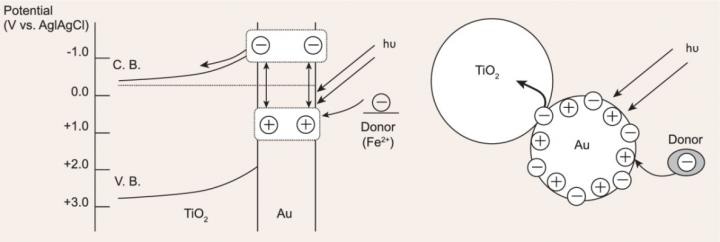Apr 28 2017
Photocatalysis through sunlight has been of significant interest to researchers to enable highly efficient solar energy conversion and for challenges in environmental remediation problems.
A number of semiconductors that have large band gaps—such as TiO2—have been shown to be very effective under UV light. Yet, while visible light accounts for nearly 43% of total sunlight, UV light constitutes just around 4% of sunlight. Therefore, in order to enable efficient practical and chemistry applications, it is highly significant to create photocatalytic materials that are responsive to visible light.
 Proposed mechanism for the photoelectrochemistry: charges are separated at a visible-light-irradiated Au NPs TiO2 system. CREDIT: Science China Press.
Proposed mechanism for the photoelectrochemistry: charges are separated at a visible-light-irradiated Au NPs TiO2 system. CREDIT: Science China Press.
For many years, photosensitization of nanoparticles (NPs) of coinage metals such as Ag, Au, and Cu over semiconductors that have a large band gap has been considered as a promising approach for creating photocatalytic materials that are responsive to visible light. In this study, mechanisms for metal-induced photocatalysis (MIP)—such as hot-electron transfer—were first outlined. Then, investigation of the advancement toward the use of MIP in photoreduction of CO2, photocatalytic and PEC water splitting, and activation of inert molecules such as CH4 and N2 was carried out. In general, improvement in visible-light responsiveness was accomplished after introducing the metal NPs. However, the apparent quantum efficiency (AQE) acquired through most of the prevalent metal-induced photocatalytic water-splitting under visible light was comparatively very low, less than 1%. Therefore, creating efficacious metal semiconductor composite (MSC) materials is specifically mandatory in this area of research. In order to reiterate this concept, the authors summed up significant researches in enhancing the efficacy of MIP in accomplishing improvement in charge-carrier separation, effective or broadband light-harvesting, decoration with cocatalyst, and so on.
In contrast, it is most certain that particle-size effect has a critical role in MIP systems. Specific attention was given to this subject, and chosen studies were assessed. Yet there has been no consensus on the subject. A few scientists asserted that larger metal NPs proved beneficial due to their strong SPR intensity, which results in high electron transfer efficiency. A few others indicated that smaller metal NPs were beneficial as they enabled the accomplishment of efficacious charge separation. A third perspective was that large as well as small metal NPs were beneficial. Hence, the subject mandates considerably greater attention.
Investigating the absorption of light by metal NPs in photocatalysis is an innovative and propitious step forward in analyzing photocatalysts that can efficiently respond to visible light. Yet there are many hurdles in accomplishing this goal. During the conclusion of the study, the researchers briefly discussed the hurdles and probable directions for developing MIP, which involve in-depth knowledge of the mechanism governing the MIP, rational design and accurate regulation of plasmonic metal, further enhancement of efficiency, and so on.